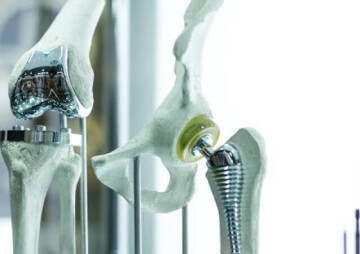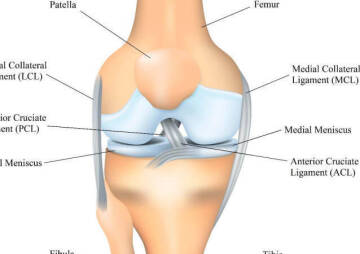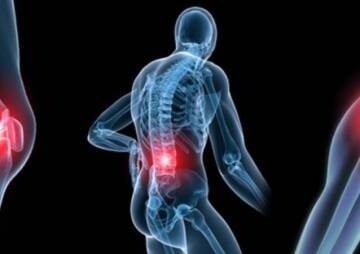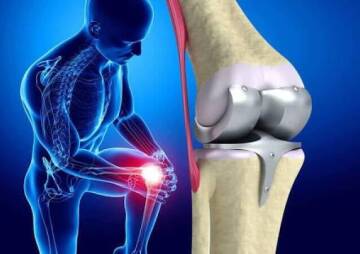-
Category
Craniomaxillofacial Surgery
Orthopedic Surgery
Spine Surgery
Orthopedic Implants
Hip Surgery
Knee Surgery
Pectus Excavatum
Bone Graft
Disinfectants
Healthcare
Plica Syndrome Is One of The Main Causes Of Knee Pain

Plica syndrome is a collection of symptoms that can affect people's lives in their first three decades of life, regardless of gender.
Are you one of those people whose knee pain affects their daily activities? Many medical factors cause knee pain, especially inner knee pain, and you may not be aware of many of them. Plica syndrome is one of these factors, and it is one of the most common causes of pain in different people. How well do you know about this syndrome? Plica syndrome is a collection of symptoms that can affect people's lives in their first three decades of life, regardless of gender. According to a 2017 study, there are several types of this syndrome, with a prevalence of 3 to 30% in European populations. These statistics show its prevalence as the primary cause of knee pain. It's better to read more about this syndrome now to see if your knee pain is also due to it.
Anatomy of the Medial Plica
It is best first to get an overview of the knee anatomy and the position of the plica. A thick tissue membrane called the joint capsule covers the bones that form the knee joint. A thin membrane of tissue called the synovial layer covers the inner surface of the knee joint capsule, and its cells are responsible for the secretion of joint fluid. Sometimes part of this synovial layer folds into the joint space that you know this fold as the plica. There are four types of plica in your knee: suprapatellar, medial plica, infrapatellar, or lateral plica; Among them, the medial plica is more susceptible to injury, and medial plica syndrome is more common. This plica is the remnants of fetal synovial tissue located on the inside of the knee. According to orthopedic surgeons, about 50 to 70% of us have medial plica, which does not cause any problems. But how does it cause knee pain?
How Does Plica Syndrome Occur?
Any activity or injury that irritates the plica will cause plica syndrome. This syndrome develops over time in people who continuously bend or straighten their knees during activities such as cycling, running, and using stair-climbing machines. However, doing heavy and unusual exercises before the body is ready, as well as accidents, can irritate the plica and cause knee pain. If you have a structural problem that affects the joint between your kneecap and the thigh bone, you are more likely to have plica syndrome. These structural problems may be related to the alignment of the knee joint or the weakness of the muscles around your thighs.
Is Plica Syndrome Hereditary?
There is no exact information about the inheritance of the Plica syndrome, but the fact that the plica exists as a fetal remnant in the knee may be inherited. Because some people may have this structure and others may not. This is a controversial issue among scientists and requires advanced studies. But according to scholars, knee pain caused by Plica Syndrome is triggered over time by specific exercises or excessive pressure on the knee. So far, there are no cases or studies showing the birth of a baby with plica syndrome.
What Are the Symptoms of Plica Syndrome?

The primary and common symptom of Plica syndrome is knee pain, particularly in the medial and front of your knees. And patients rarely feel pain behind the kneecap. It's interesting to know that the knee pain caused by this syndrome is achy rather than sharp and worsens when you put more pressure on your knee, such as using stairs, squatting, or bending. There are also various additional symptoms that differ from person to person, depending on the type and intensity of the injury. Some of these symptoms are:
- Difficulty sitting for a long time
- The feeling of locking the knee after sitting on a chair for a long time
- The feeling of instability on stairs
- Hearing clicking or cracking sound when bending the knee. This sound is due to the slipping of a thickened plica on the femur's condylar surface inside the knee joint.
- The feeling of something bumping in the knee, which is often present in the early morning but gradually disappears after daily activities.
- When you press your kneecap, you'll find a swollen plica
- Feeling the knee going out
In addition to knee pain, which of the above symptoms do you have? Some patients say that we only have one or more of these symptoms, so it means that our knee pain is not due to plica syndrome. However, this is a wrong attitude because all these symptoms do not appear in a person and their types and severity differ from patient to patient. If so, talk to your doctor if you want precise information about this syndrome and its symptoms.
How is Plica Syndrome Diagnosed?
Diagnosing Plica syndrome is sometimes a complicated process, even for your doctor. As previously stated, a variety of factors contribute to knee pain, especially inner knee pain, and diagnosis, which necessitates specific approaches. For example, a torn meniscus or tendonitis can also make your knee painful, but the diagnostic methods are different. Now, how is plica syndrome diagnosed?
Clinical Examination

The specialist will consider looking over the patient's medical history and performing a clinical examination. Every surgeon has his series of exams, making a relative diagnosis of the disease. Clinical examinations are a series of tests that accurately indicate a doctor's diagnosis and treatment options, but they are not definitive. Orthopedists administer these tests to evaluate three aspects: patellofemoral joint/extensor mechanism, articular lesions, and knee instability. Each of these three categories has its trials, which are:
- Patello-Femoral Joint tests include J sign, Q angel, Patella tracking, MPFL palpation test, and Patellar Glide
- Articular lesions tests include McMurray test, Apley's (grinding) test, Bohler's test, Squat test, and duck-walking test
- knee instability tests include valgus (abduction) and varus (adduction) tests, Cabot's maneuver, Anterior, and Posterior Drawer Test, The Lachman test, Quadriceps Active Test, Pivot Shift (Jerk) Test, and Noyes' Glide Pivot Shift Test
These measures help diagnose plica syndrome, although they do not always have conclusive results. And maybe confused with other causes of knee pain. As a result, orthopedists often use cutting-edge technology to obtain accurate results and diagnose plica syndrome.
Is Plica Syndrome Shown On MRI?

Many people assume that using X-rays to diagnose plica syndrome is acceptable, but doctors have found that this procedure does not effectively show plica. This is where the magnetic resonance imaging (MRI) foot comes in. This technique uses magnetic waves to indicate problems like tears in the meniscus and ligaments of the knee. Therefore, MRI can easily show any inflammation and damage to the plica.
Does Plica Syndrome Go Away?
This question may be the question of many patients. Do you know why? People believe that knee problems will never heal and that therapies will not work. In the case of plica syndrome, the opposite is true, so that even at home, you can fix this knee problem. Studies show that about 60% of patients with plica syndrome successfully recover within 6 to 8 weeks with non-surgical treatments. This is a promising statistic, so if your doctor diagnoses Plica Syndrome, don't worry because it will be treated. In this article's continuation, you are given all the necessary and basic methods for treating this syndrome.
Treatment of Plica Syndrome
Fortunately, plica syndrome responds well to treatment compared to other causes of knee pain. When it comes to treatment, you may think it means knee surgery, while plica surgery is the last and rarest choice in treating this issue. Self-help and exercise are the main options for treating plica syndrome, and patients are often given good outcomes.
Self-help methods
Try to reduce or stop activities that cause stress on the knee, such as running, jumping, or climbing stairs, before taking any action. Other alternative activities, such as swimming, will help you maintain your fitness. Use anti-inflammatory medicines such as ibuprofen to alleviate pain. Doctors also recommend putting an ice pack on your knee for 20 minutes every two to three hours to reduce inflammation. These are self-help tasks that are best done before beginning practical exercises to treat inflamed plica.
Exercises

The most effective treatment program for Plica Syndrome is to perform exercises that strengthen the muscles around the knee, such as quadriceps and hamstring. Get the Physical Therapist's advice on how to perform these exercises correctly, as doing them wrong may result in other serious injuries to your knee. And, the good news is that patients experience improvement 6 to 8 weeks after beginning exercise and physical therapy. These practical exercises are:
Quadriceps strengthening
Having a strong quadriceps is advantageous because it lowers the risk of plica inflammation. According to statistics, people with weak quadriceps muscles were more likely to develop inflammation in the plica. This is because plica is indirectly attached to the quadriceps muscles. You now know that you need to strengthen the quadriceps muscles to treat irritated plica. Strengthening exercises for these muscles include:
- Quadriceps set exercise
- Leg press exercise
- Stationary bike exercise
- straight leg raises
- mini-squats
- Swimming
- Walking
- Biking
- Using an elliptical machine
Hamstring stretching
In addition to strengthening your quadriceps, you should also strengthen your hamstring muscles. The muscles behind your thighs or hamstrings allow you to extend your legs back and bend your knees. These large muscles do not play a significant role in daily activities, such as walking, and most of their uses are in strength activities, such as running, jumping, and climbing. Hence hamstring injury is a significant source of plica inflammation. To strengthen the hamstring muscles, it is better to do the following exercises on a regular schedule:
- Standing knee bend: To keep your balance, stand up straight and grip the back of the chair or table with both hands. Stand on one leg and bend the knee of the other leg and keep it for three seconds.
- Bend the knee with a resistance band: Tie the resistance band to the sole of your foot on one side and the other to the ankle. Lie on your stomach, raise your knees to your hips and stay for three to five seconds.
- Air Squat
- Partner Hamstring Curls
- Stiff-Leg Dumbbell Deadlift
In most cases, these treatments alleviate the symptoms of Plica Syndrome and make patients feel better. But what if the symptoms don't go down after two or three months?
Intra-articular corticosteroid injection
This injection aims to reduce the pain and symptoms associated with this syndrome so that patients can take part in exercise therapy programs. Unfortunately, some patients rely solely on intra-articular corticosteroid injections and skip physiotherapy. Even if symptoms relieve after injection, you should engage in exercise programs because if you do not have strong quadriceps and hamstrings, your plica can get inflamed again. But physiotherapists should prevent you from doing something that puts stress on your knee 24 to 48 hours after the injection. Otherwise, you may experience post-injection sore knee joints.
Additional suggested treatments
In addition to exercise therapy programs, your physical therapist can recommend additional effective therapies for Plica Syndrome. For example:
- Massage or manipulation of your knee joint
- Tap your knee or wear a support brace
- Wearing orthoses
- Apply medicinal plant extracts to reduce inflammation
- Wear appropriate medical shoes
Surgery

Will I need surgery? Undoubtedly, this question is in the minds of many patients. As mentioned earlier, medial plica surgery is the last option to improve this condition. Surgeons recommend surgery if none of the treatments or exercise programs cure the plica's inflammation, and the patient's symptoms and pain do not worsen over time. You may be one of those people who are afraid of surgery, but you should know that Plica surgery, which is called arthroscopy, is a painless and straightforward operation. So, what is 'Arthroscopy? ' In this operation, the surgeon inserts a fiber- optic camera inside the knee joint to see the knee joint's internal structure directly. Thus, the doctor can see the inside of the knee and diagnose inflammation in the plica and treat it at the same time. This is an outpatient procedure, and your doctor will usually use sedatives for your comfort during the operation. This means that you can go home on the day of surgery. Arthroscopy is an innovative technology for identifying the causes of knee pain that paved the way for treating knee problems.
Recovering from surgery
The recovery period of arthroscopic surgery varies from patient to patient, depending on various factors. For example, the patient's anatomy and physiology and the type of procedure performed in arthroscopy are important factors. It takes two to six weeks to recover fully. You should rest and avoid doing activity such as exercise, shopping, or lifting heavy things during this time. Your doctor will refer you to a physiotherapist after surgery to help you strengthen your knee again. You start with light exercises that reduce pain and swelling, and you gradually strengthen your quadriceps and hamstrings by doing more strenuous exercises. If you continue with this program, you can be sure that your knee pain will improve completely after 3-4 months.
Can Plica Syndrome Come Back?
The answer to this question is both yes and no. If you have used non-surgical methods to treat Plica Syndrome, this problem may come back. But how? Suppose you rely solely on corticosteroid injections and do not engage in strengthening exercises. In that case, the symptoms will reappear after a short period. Or, if you skip your exercise program, you may not be able to get rid of knee pain.
On the other hand, after arthroscopy, the plica may grow again but will no longer be asymptomatic. Under these circumstances, plica syndrome will not return, and you can safely do your favorite things. But in general, to avoid any injury to the knee, you need to be very careful and have a healthy lifestyle. A balanced diet, healthy weight, exercise, and knowledge of how to sit correctly have a significant impact on the knee's health.
To Sum Up
By reading this article, you got everything you need to know about Plica Syndrome. But in short, plica is present in most people's knees and normally does not cause a problem. According to studies, plica is located in 87% of the knees in the upper part of the patella, 72% of the knees in the inner part, and 86% in the lower part of the knee. Upper and lower knee plica rarely cause pain, and what causes inner knee pain is medial plica. To learn more about medial knee pain, click here to read the related article. However, it is controversial whether plica syndrome is hereditary or not. What is your opinion? Please write us your valuable comments below.






